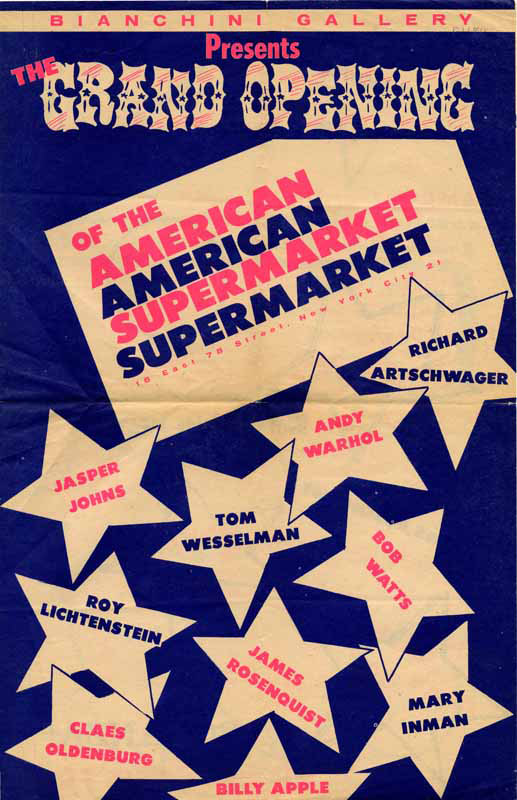‘POP ART’.
The term has been used so often that people are no longer quite sure what it
was ever originally supposed to be – is it
a movement, is it a concept, is it a hybrid or is it just a neologism? I
myself used to be sceptical of the term, my knowledge of the movement extending
only to the Campbells soup cans of Andy Warhol and the cartoon prints of Roy
Lichtenstein, an American artist whose fabulous exhibition at the Centre
Georges Pompidou truly ignited my interest earlier today.
 |
| Lichtenstein Poster |
The
exhibition was a walk-through of Lichtenstein’s fascinating career – his flirtations
with cubism, his years of ‘image duplication’, his use of abstract materials
and even his comic-strip commentaries on wartime America. However, despite all
of this, the beginning of his career was the era which caught my eye the most;
the time period in which he was intrigued by the brutally direct slogans and
ubiquitous imagery of the advertising industry. Everyday items such as coffee
cups and hot dogs became staples of American culture through advertising,
therefore becoming (due to America’s worldwide dominance) representations of ‘pop
culture’. Lichtenstein created sculptures and paintings of these everyday
objects in three primary colours – pillarbox red, lemon yellow and marine blue
(and, on occasion, green). The striking impact of the graphic paintings was
made to imitate the eye-catching statements of American advertisement, a
commentary on the way that advertisers would shove the ideal of ‘the American
dream’ in the face of their prospective consumers.
 |
| Lichtenstein - 'A Cup of Coffee' |
Another
element was to broaden the art world, moving it away from ‘niche’ territory and
showing artists that ‘pop’ wasn’t a dirty word. In this era (1950s &
1960s), the art world was seen as being exclusive and, therefore, elitist – a stereotype
that Lichtenstein, Warhol and other prominent Pop artists sought to dispel. The
purest representation of this ideology was presented in the form of ‘The
American Supermarket’ exhibition – a real supermarket stocked with fake
foodstuffs such as chrome cabbages and wax tomatoes. The supermarket also sold
$2 tote bags screened with images of Warhol’s soup cans as well as Lichtenstein’s
turkey, essentially making art accessible to all. What interest me the most is
that art welcomed pop in this way, but the favour was never really returned –
while many of recognise the Mona Lisa when we see it or perhaps have bought the
occasional £7.99 Salvador Dali calendar, there have been very few examples of
high-art that are pivotal to pop culture.. until recently.
 |
| 'the American Supermarket' |
Throughout
the past few catwalk seasons, references to artists (both well-known and not-so-well
known) seem to be a more frequent occurrence. The first (and most relevant to
this article) example would be of Miuccia Prada’s S/S 2014 extravaganza, the
set itself commissioned and designed by four upcoming street muralists. Then
there was the collection itself – replicas of the female heads on the murals
were superimposed onto most pieces, and the graphic primary colours of the fur
coats were more than a little reminiscent of Lichtenstein himself. Then there
was Raf Simons’ decision to raid the archives and illustrate his classic gowns
with motifs from Warhol’s illustration days; an embroidered tulip here, a dainty
painted stiletto there.
 |
| Prada S/S 2014 |
Maison
Martin Margiela as a house is also a pioneer of the ‘art’ movement within
fashion, to the extent that their couture line is simply named ‘Artisanal’.
Fabricated entirely from found objects or swatches and pieces from past
collections, the idea is to create new pieces from recycled materials. However,
due to unconventional materials (some which, for example, are impossible to
sew), the house tend to either use embellishment techniques or they look
towards a fabrication method more often used to create sculptures, rendering
the clothing almost an artwork in their own right. This leads me to the final
piece of evidence in the fight to introduce art into pop culture – Lady Gaga. A
pop cultural force with enough Twitter followers to create and inhabit their
own private country, Gaga’s latest opus ‘ARTPOP’ is attempting to introduce cult
artists such as Jeff Koons and Marina Abramovic by referencing them in her
lyrics, collaborating with them on projects and staging her album launch party
in the form of the ‘artRAVE’ – a night which will essentially act as an
exhibition with her music as a backdrop.
 |
| Maison Martin Margiela Artisanal |
Although
art has infiltrated pop culture in the past, the references now seem to be more
varied and the interest more genuine. Figures such as Miuccia Prada and Lady
Gaga are a huge part of ‘pop culture’ today, meaning that their endorsements
give art a bigger chance than ever to become mainstream. Whether or not this is
a good thing is debatable; many see it is a representation that art is losing
its exclusivity (not my argument – surely art is just another area of
education, and accessible education can never be a bad thing?) whereas others
have branded Koons and, in particular, Abramovic as ‘sell-outs’ for working
with Gaga. These feeble arguments highlight the unfortunate ‘elitist’ nature
that does still plague art – just because I have been exposed to Lichtenstein,
Koons, Abramovic and Warhol, it doesn’t make me want to become an artist, it’s
just another area of culture which helps broaden knowledge of reference points
and art movements. But as to whether or not art and pop culture can co-exist,
the answer will unravel as Gaga’s new album (the cover a hybrid of Botticelli’s
Venus and a Koons sculpture of Gaga herself) takes over the shelves of
supermarkets and record stores worldwide, recreating the ‘American Supermarket’
experience of finding respected artists available to purchase.
 |
| 'ARTPOP' |

No comments:
Post a Comment